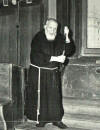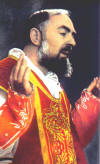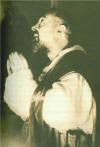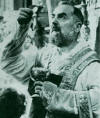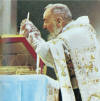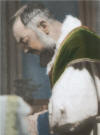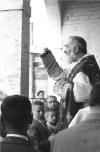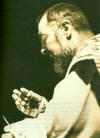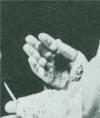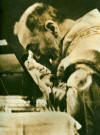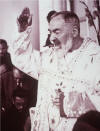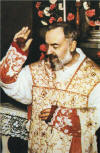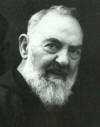16
Mass and confessions
Summary: Mass; 11 altars; most famous picture; Confessions, two confessionals, the Judgement, uncompromising, some "go away".
Padre Francesco Napolitano: “Padre Pio’s entire priestly life was
contained between two most brilliant lights: the altar and the
confessional.[1]
Padre Pio: “God elects the priest for the Altar and the confessional.”[2]
Mass
Fra' Angelantonio pulling the cord of the bell, to invite people to Padre Pio's Mass.
Five in the morning
Being at five in the morning near the altar of Padre Pio was really a
close encounter of the special kind with the supernatural.
Golgotha
The Mass of Padre Pio was a spectacular mystical event, mixing the
height of the human complete immolation to God, that we could see, with
a mystical and physical renewal of the Passion of Christ from the Garden
to the Golgotha, which we couldn't see, but were able to feel.
Padre Pio: “Jesus associated me to the great endeavor of the human
redemption. The Heavenly Father let me ascend on the Cross of His Son. I
am sure that from there I will never get down.”[3]
Witnesses
Mary Ingoldsby: “The early morning call to climb the steep hill to the
friary for the 5 AM Mass was a penitential rite in itself.”[4]
During Mass “His face suggested the face of a suffering Christ bowed
down beneath the weight of the cross.”[5]
Padre Pio Capuano: “There is no report of any other place in the world
were people would be waiting for hours at the locked door of a church,
rain or shine or snow or wind or cold, to attend to a Mass celebrated at
four or five in the morning.”[6]
Padre Francesco Napolitano: “As soon as the doors of the church opened
there was a terrible commotion to get to the altar were Padre Pio was to
celebrate. Then, as soon as Padre Pio was in the doorway a veil of
silence fell, creating an air of heavenly sensation.”[7]
Padre Alessio: “As he walked towards the altar with great difficulty, he
recited the Miserere psalm with deep compunction and humility.”
[8]
Rev. Karol Wojtyla, future Pope John Paul II, “in April 1948” attended
Padre Pio’s Mass: “It was long. He was suffering profoundly. On the
altar, in San Giovanni Rotondo, the sacrifice of Christ himself, the
bloodless sacrifice, was taking place, and at the same time, the bloody
wounds on the hands made me think of the whole sacrifice, of Jesus
Crucified. This event stayed with me as an unforgettable experience.
This memory lasts until today and somehow, today I have before my eyes
what I myself saw then.”[9]
Guido Piovene: “Padre Pio celebrates Mass in a state of ecstasy and
rapture.”[10]
Nino Salvaneschi: “When Padre Pio celebrates Mass gives the feeling of
being in a different world; he is truly with God.”
“During Mass Padre Pio seemed to
belong to a humanity that was superior to ours.”[11]
Oscar De Liso on 1961: “In the Mass as Padre Pio goes into ecstasy, he
becomes a spectacle of agony. His eyes are shut, his face contorted in
pain, his lips trembling, his cheeks wet with tears. His ecstasy lasts
long, while he relieves the Passion of the Cross. For several minutes he
leans on the altar and weeps, standing perfectly still in mystical
transport. The expression of his face is that of a nomad of the beyond.”[12]
Bishop Giuseppe Petralia: “His Mass was a mission of reparation.”[13]
Luigi Peroni: “On the altar, in Padre Pio’s flesh the whole Passion is
lived again: the agony, scourging, thorns, crucifixion, and the piercing
of the chest with a lance.”[14]
“Mons. Paolo Carta, archbishop of Sassari 1962-1982: “At the altar one
had the impression that space and time had been cancelled between the
altar and the Hill of Calvary.”[15]
[16]
Padre Domenico Mondrone: “Anyone
who has attended Padre Pio’s Mass, has seen the distance between the
altar and the Calvary annihilated.”[17]
Padre Clemente Naef noted that after the consecration Padre Pio’s head
jerked sharply from time to time “as though he had been struck in the
face”.[18]
Padre Giovanni da Baggio: “Certain nervous twitching’s of his face,
certain glances upward, certain movements of his head as he was chasing
away something vexatious, suggested deep suffering and great efforts to
keep him from being caught up into ecstasy.”[19]
[20]
Padre Tarcisio Zullo: “Padre Pio made the Lord’s Passion his own.”[21]
Padre Luigi in 1921: “Padre Pio celebrated Mass, after hearing
confessions for a very long time, around 11:30 AM. This Mass was
considered a solemn one. The Mass was always accompanied by the organ.
Now only on Sunday the Mass is chanted.[22]
The Mass he now celebrates at 10:00 AM, is the Conventual.”[23]
Padre Innocenzo: “I was assistant to Padre Pio in 1951-3. His alarm
clock was always set for 2:30 AM. Each morning went to his cell to
accompany him down to the sacristy. I always found him ready and waiting
for me, with the beads hidden in his hand while he recited the Rosary.”[24]
Alberto Del Fante: “In the Mass Padre Pio reenacts the Passion, becoming
a living sacrificial victim.”
[25]
John McCaffery: “When the Mass reached the Consecration one felt that
truly this was the center of the Universe.”
[26]
Malachi Gerard Carroll: “With Padre Pio on the altar, Calvary becomes a
reality, and the Mass appears in all its shattering wonder for each and
all.”[27]
Wanda Poltawska: "The Mass Lasted a long time but the people who filled
the church were completely still, transfixed by the Eucharist made real
to them by this extraordinary man.”[28]
Graziella Cascavilla: “It was like having Christ in our midst.”[29]
Nina Campanile: “Padre Pio was a divine man.”[30]
Don Pierino Galeone: “I have seen Padre Pio on the altar taking the
appearance of Jesus.”[31]
Giovanni Bardazzi da Prato was at the Mass of Padre Pio out of
curiosity. “I was observing the celebrant. He seemed to suffer terrible
pains. I didn’t believe there is a God, but I had a thought: ‘This Mass
is getting too long. If you exist let me suffer what he is suffering’.
In an instant is seemed that I was going through the most atrocious
tortures. I cried inside me: ‘Stop. If it lasts one more moment I will
be dead.’ The pain stopped. Nobody around me noticed anything. I have
learned to never challenge God.”[32]
Bill Carrigan: “As he began the consecration he seemed to be in great
pain, shifting his weight from side to side, hesitating to begin the
words of consecration which he would start and repeat, and biting them
off with a clicking of his teeth as if in great pain. His cheek muscles
twitched and tears were visible on his cheeks. He reached for the
chalice and jerked back his hand violently, as it the pain was so great
he couldn’t grasp it. After the Consecration he seemed exhausted and
leaned forward as in deep meditation.”[33]
William Carrigan, of the 15th Air Force, assigned at Christmas time 1943
to the American Red Cross Field Office in Foggia.
Father John D. Saint John: “During the Mass he seemed to be in ecstasy.
At the Consecration, holding the Host up, he seemed to be out of this
world. He seemed not to know where he was. His eyes were aglow.”[34]
Father John was a Jesuit chaplain in the fifteenth Army Air Force in
1943.
Ray Nunten: “When Padre Pio says Mass he seems to be transfigured into a
celestial being. You can see him twisting and moving about in agony, and
tears roll down his cheeks. When he offers up the Host, he doesn’t look
directly at the Host, but just over it, into the air; and the look of
his earthly face is not of this world.”[35]
Raymond Bunten in 1944 was in the 345th Signal Company Wing.
Joe Peterson: “His eye where fixed in a particular spot. He would speak
although you couldn’t hear him. You would see his lips moving. He seemed
to be in conversation with invisible beings.”[36]
In 1943 Joe Peterson was an American GI stationed in Bari at the
military post office.
Father John Esseff, from Scranton, Pennsylvania, in May of 1959,
accompanied by his friend Father Bob Calligan, went with Mary Pyle to
Padre Pio’s Mass.
John reported: “That night
was chilly, and at 2:00 AM we went to the door of the church. Mary Pyle
told us that as soon as we entered we had to go into the sacristy and
sign up for an altar to say Mass. In pre Vatican II, concelebration was
not allowed. While we both were signing up, Padre Pio came into the
sacristy to vest for his Mass. Everyone immediately knelt down. A short
time later he came over to me, he took off his glove and I could see the
hole in his hand. In fact, I
could see the light through the hole. A few minutes later he began
Mass. The Mass lasted for about three hours. At the consecration, he
held the host up for at least twenty minutes.”[37]
Padre Pio
"It would be easier for the earth to carry on without the sun than
without the Mass."
[38]
[39]
“The Mass gives God infinite glory.”[40]
“The benefits of Mass cannot be enumerated. We will see them in
Paradise.”[41]
“I’d never leave the altar. I’d like to celebrate sixty Masses a day.”[42]
"If people knew the value of the Mass, there would be policemen at the
door, to regulate the access to the church, every time that a Mass is
celebrated".[43]
"I see all my children who come to the altar, as if in a mirror."[44]
“I am unworthy to represent Jesus on earth, to be Christ on the altar.
The responsibility of the priesthood scares me."[45]
[46]
"At the Calvary, there where screams, blasphemies, loud clamor, and
threats... that was really uproar."[47]
To Padre Tarcisio Zullo: “In the Mass I suffer as far as it is possible
for a human body. I suffer the scouring from the beginning to the end of
the Mass, more intensely after the Consecration. The Communion is the
culminating point of my suffering. During Mass I am not standing; I am
hanging.”
The most famous picture of Padre Pio
This picture was taken by Elia Stelluto. Here is how Elia described it:
"In
the 40's there was the war going on, and I was a teen ager, and there
were no regular schools, and I frequented daily the convent.
“I bought a small camera and took picture of Padre Pio; many of them.
One day my masters, the photographer Federico Abresh, asked me if I
would take a picture of Padre Pio with the flash, at the moment when He
turned to the assembly to give the final blessing. He said that he would
give me 5000 lire (the equivalent of what I could make in a year).
Padre Pio was known to dislike the light of the flash, and it was
prohibited to use it.
I prepared myself during the Mass, and took the picture from about five
feet. Padre Pio didn't like the flash.
After the Mass I went to him in the sacristy to apologize.
He was very sweet and made me promise to
"take as many pictures as you want, but never use anymore that
mousetrap"
(the bulky flash of the old days).
I will never forget the moment that I took that picture of Padre Pio
with the white carnations in the background.
By the way, I refused the 5000 lire, because I had made Padre Pio mad."
Confession
How many
Padre Pio spent most of his day hearing confessions.
[48]
From 1918 until about 1923 Padre Pio heard confessions fifteen to
nineteen hours a day.[49]
Padre Pio frequently heard confessions for fifteen hours a day,
sometimes even for nineteen hours. He was a martyr to this duty, a
martyr to the sacrament of mercy.[50]
During the 40's and 50's, He confessed about eight hours a day.
In 1962, 83.035 women and 19.837 men registered for confession with
Padre Pio: an average of about 273 per day.
In 1967 Padre Pio confessed about 15.000 women and 10.000 men. That’s an
average of 70 people per day.
For the women there was a confessional. The men confessed kneeling on a
kneeler, in the old sacristy.
It has been estimated that he heard at least 5 million confessions.[51]
The Judgement
The average confession made to Padre Pio lasted only three minutes.
Padre Pio demanded that each confession be a true conversion.
No excuses, no insincerity, but frankness, honesty, firm resolution.
It was like being before the judgment of God.
Padre Pio had strong views on female fashions in dress. A sign read: "By
Padre Pio’s explicit wish, women must enter his confessional wearing
skirts at least eight inches below the knees. It is forbidden to borrow
longer dresses in church and to wear them for the confessional.”
Francesco Napolitano: “Padre Pio was a most severe confessor. Everyone
trembled before him.”[52]
Padre Pio in the confessional went straight to the point: Christ
crucified.[53]
Pope John Paul II in the Canonization of Padre Pio Mass: “He was a
generous dispense of divine mercy especially through the sacrament of
penance.”[54]
Pius XII: “The greatest sin is that men have started to lose the sense
of sin.”[55]
Paul VI: “Once human mind has separated from the divine wisdom the
concept of sin has been lost.”[56]
Padre Pio
To a priest: “What a dreadful thing is to sit in the tribunal of
confession, were we dispense the blood of Christ! Take care not to throw
it away too easily.”[57]
After a day of confessions: "Oh the souls! If you knew how much they
cost!"[58]
“I should prefer death rather that offending God.”
“I would prefer martyrdom rather than offending God even in a
single instance.”[59]
Uncompromising
Francesco Napolitano: “Padre Pio never compromised with evil, no matter
who the sinner was.”[60]
Padre Pellegrino: “For him every confession had to be a sign of
conversion.”[61]
Padre Pio wanted to bring lost souls back to God as soon as possible: "I
can hit my children. I want to bring them up fast, even with blows".[62]
Padre Marcellino: “Padre Pio found himself trapped between compassion
and duty.”[63]
“Padre Pio’s interventions seemed at times insensitive and a bit rude.
They were part of a long mysterious selection and preparation, reserved
especially to those souls who would have become part of his big family.”[64]
Brusque manners were used at times by Padre Pio to shake up and bring
repentance, to keep away the curious and the fanatics.
There was always a reason for
his roughness. People actually snipped bits off his habit with nail
scissors when they knelt in the corridor as he was passing.
"Go away. What are you her for? What do you want from me? They cut my
cord and habit with scissors. This is paganism. This is fanaticism."[65]
"I'm forced to be rude. I am sorry, but if I don't act this way, they
will kill me."
[66]
Padre Tarcisio asked why he was so strict with some people. “My son,
before making people suffer, I suffer a lot myself. But it’s necessary,
because my job is to remove the old and put in the new.”[67]
Padre Pio wanted to bring lost souls back to God as soon as possible: "I
can hit my children. I want to bring them up fast, even with blows".[68]
Padre Joseph Pius: “I call Padre Pio an actor for souls.”[69]
Some “go away”
At the confessional, before a man could open his mouth: “Go away. In
agreement with your wife you have aborted three times!”[70]
Padre Pio: “Do you go to Mass?” Reply: “I have missed Mass ten or twenty
times.” Padre Pio: “After ten comes eleven. Go away.”[71]
A person was confessing bad thoughts against chastity. Padre Pio: “How
many times?” “Six or seven.” Padre Pio: “Seven is not the same as six.
It means one more deadly sin.” The person was sent away.[72]
One woman who came on a long trip to see Padre Pio said to him in
confession, “Padre Pio, four years ago I lost my husband and I haven’t
gone to church since then.” Padre Pio replied: “Because you lost your
husband, you also lost God? Go away! Go away!”
Some friars asked Padre Pio: “When you don’t give absolution, those
souls come to us. What should we do?” Padre Pio: “You must give
absolution. There is only one Padre Pio.”[73]
To Padre Pellegrino: “When I don’t give absolution, it is to me that I
don’t give it.”[74]
Padre Pio
"Sometimes words must be a little angry externally, however, serenity
never leaves me."[75]
“It is better to be reprimanded by a man in this world than by God in
the next.”[76]
"Do as I do. If I have an outburst, internally I am always serene."[77]
[78]
“After I give the absolution I accompany all my penitents as I was their
shadow.”[79]
“It is for the souls that I feel the pain of this trial.”[80]
After a day of confessions: "Oh the souls! If you knew how much they
cost!"[81]
"Before reproaching a soul, I suffer it first. But it is not I who act,
but He who is in me and above me."[82]
"The mercy of God, my son, is infinitely greater than your malice.”[83]
“Never say to God: I have sinned and deserve your punishment. Rather
say: I have sinned but me merciful to me.”[84]
“It is difficult that a soul not persistently evil is damned, because
God at the moment of death asks: Do you want me? Those who want to go to
hell go there.”
[85]
"Do not dwell on sins that have been already confessed. Jesus has
forgiven them."[86]
“As long as you are afraid to fall, you will not sin. You should be afraid when you are not afraid anymore.”[87]
“If a doctor takes pity on a patient, he will make a wound gangrenous.”[90]
To Padre Carmelo, superior of the convent: "I'm only superficially
upset. But my heart is always calm and serene".[91]
“I act in such a way, because my heart of father wants to recall souls
to penance. I can’t bear that they remain in sin.”[92]
“I treat people the way they deserve before God.”[93]
“To rouse certain souls you need cannonballs. Treating them with
gentleness is a waste of time.”
[94]
“I always keep my promises. Whatever I start, I finish it.”[95]
To an unrepented: “Well, if you want to go to hell, I don’t. You want to
pull me there too.”[96]
“I don’t condemn dancing as such, but I believe there is always the
danger of sin.”
[97]
“If I reproach someone, it is for the benefit of their soul.”[98]
“I don’t give a candy to someone who needs a purgative.”[99]
"Do not dwell on sins that have been already confessed. Jesus has
forgiven them."[100]
Once Padre Pio lamented with Padre Gabriele Bove: “There is not one who
has asked to be helped to become a saint.”[101]
Bibliography
Alberto,
D'Apolito P. (2007). Padre Pio of Pietrelcina. Memories. Experiences.
Testimonials. San Giovanni Rotondo: Edizioni Padre Pio.
Alb07
Alessando, da Ripabottoni
(Saint Pio of Pietrelcina. Everybody's Cyrenean). 2010.
San Giovanni Rotondo: Edizioni Padre Pio.
Ale10
Bardazzi, G. (2003). Un discepolo di
Padre Pio. Citta' Ideale.
Bar03
Capobianco, C. P. (2006). Words and
anecdots of Padre Pio. San Giovanni Rotondo: Edizioni Padre Pio.Cap06
Capuano, P. (2012). Con p. Pio: come
in una fiaba. Foggia: Grafiche Grilli.
Cap12
Castelli, F. (2011). Padre Pio under
investigation. The secret Vatican files. San Francisco: Ignatius
Press.
Cas11
DeLiso, O. (1962). Padre Pio. New
York: All Saints Press.
DeL62
Duchess Suzanne, o. S. (1983). Magic
of a Mistic. Stories of Padre Pio. New York: Clarkson N. Potter.
Duc83
Flumeri, G. d. (1996). Positio super
virtutibus Betifications et Canonizationis servi Dei Pii a Pietrelcina.
6 thomes, synthesis of 104 volumes of diocesan process. Roma:
Capuchin Order.
Flu96
Gallagher, J. (1995). Padre Pio, The
pierced priest. London: HarperCollins.
Gal95
Gaudiose, D. M. (1974). Prophet of
the people. A biography of Padre Pio. New York: Alba House.
Gau74
George, Essef
(2010). Brothers & Fathers. By monsignor John Esseff and
George Esseff. As told by Ellen Franco. East Stroudsburg, PA: EME
Press.
Ess10
Iasenzaniro, M. (2007). Charismatic
piest. Testimonies. San Giovanni Rotondo: Edizioni Padre Pio.
Ias07
Iasenzeniro, F. M. (2006). The
"Padre" saint Pio of Pietrelcina. His mission to save souls.
Testimonies. San Giovanni Rotondo: Edizioni Padre Pio.
Ias06
II, John Paul (2002). Canonization of
Padre Pio. Osservatore Romano.
II,J.P.
Ingoldsby, M. (1978). Padre Pio. His
Life and Mission. Dublin: Veritas Publications.
Ing78
McCaffery, J. (1978). Tales of Padre
Pio. Kansas City: Andrews and McMeel.
McC78
Morcaldi, C. (2013). La mia vita
vicino a Padre Pio. San Giovanni Rotondo: Edizioni Casa Sollievo.
Mor13
Multiple. (2009). Padre Pio The
wonder worker. New Bedord, MA: Franciscan Friars of Immaculate.
Mul09
Napolitano, F. (1978). Padre Pio of
Pietrelcina. A brief biography. San Giovanni Rotondo: Edizioni Padre
Pio.
Nap78
Padre, P. d. (2010). Have a good day.
San Giovanni Rotondo: Edizioni Padre Pio.
Pio10
Peroni, L. (2002). Padre Pio da
Pietrelcina. Borla.
Per02
Ripabottoni, Alessandro da (2010).
Padre Pio racconta e dice. San Giovanni Rotondo: Edizioni Padre Pio.
Ale10
Ruffin, C. B. (1991). Padre Pio: the
true story. Huntington, Indiana: Our Sunday Visitor, Inc.
Ruf91
Schug, J. O. (1987). A Padre Pio
Profile. Petersham, MA: St. Bedès Publications.
Sch87
Winowska, M. (1988). Il vero volto di
Padre Pio. Milano: Edizioni San Paolo.
Win88
[1] Nap78, 80
[2] Mor13,100
[3] Mor13, 68
[4] Ing78, 105
[5] Ing78, 105
[6] Cap12, 75
[7] Nap76, 54-5
[8] Ing78, 103
[9] Cas11, 70-1
[10] Positio IV, 46
[11] Nap76, 71
[12] DeL62, 10
[13] Ing78, 99-100
[14] Per02, 415-6
[15] Ruf91, 292
[16] Ing78, 101-2
[17] Nap76, 57-8
[18] Ruf91, 292
[19] Ruf91, 292
[20] Ing78, 102
[21] Ias07, 492
[22] Cas11, 173-4
[23] Cas11, 178
[24] Ing78, 102-3
[25] Ing78, 194
[26] McC78, 50
[27] Mul09. 95
[28] Gal95, 183
[29] Ias07, 438
[30] Ias07, 438
[31] Gal09, 69
[32] Bar03, 31-2
[33] Ruf91, 258
[34] Ruf91, 262
[35] Reg05, 175
[36] Ruf91, 292
[37] Ess10, 144
[38] Pio10, 119
[39] Cap12, 76
[40] Cle88, 187
[41] Cle88, 181
[42] Cle88, 179
[43] Cap12, 76
[44] Chi99, 232
[45] Alb07, 259
[46] Ale10, 358
[47] Mor13, 230
[48] Win88, 30
[49] Ruf91, 294
[50] Ing78, 67
[51] Ing78, 74
[52] Nap76, 68
[53] Ias06, 34
[54] Joh02, 2002
[55] Ias06, 22
[56] Ias06, 22
[57] Ing78, 67-8
[58] Cap12, 83
[59] Ias06, 20
[60] Nap76, 67
[61] Iase06, 107
[62] Per02, 387
[63] Ias06, 57
[64] Ias06, 51
[65] Fer10, 453
[66] Alb07, 237-8
[67] Per02, 387
[68] Per02, 387
[69] Sch87, 68
[70] Iase06, 132
[71] Ias06, 49
[72] Jas06, 50
[73] Cap06, 112-3
[74] Jas06, 54
[75] Sch87, 57
[76] Ing78, 68
[77] Alb07, 279
[78] Fer10, 453
[79] Ias06, 350
[80] Ias06, 351
[81] Cap12, 83
[82] Alb07, 280
[83] Ale10, 304
[84] Ias06, 197
[85] Ias06, 198
[86] Pio10, 76
[87] Del62, 556
[88] Pio10, 16
[89] Duc68, 20
[90] Gau73, 154
[91] Ias06, 31
[92] Ias06, 28
[93] Car02, 78
[94] Ias02, 30
[95] Ias06, 358
[96] Ias06, 41
[97] Ias06, 147
[98] Ias96, 32
[99] Nap76, 67
[100] Pio10, 76
[101] Ias06, 106-7


